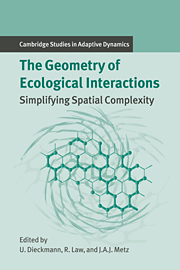Book contents
- Frontmatter
- Contents
- Contributing Authors
- 1 Introduction
- Part A Empirical and Statistical Background: A Plant Ecological Perspective
- Part B When the Mean-field Approximation Breaks Down
- Introduction to Part B
- 6 Grid-based Models as Tools for Ecological Research
- 7 Coexistence of Replicators in Prebiotic Evolution
- 8 Games on Grids
- 9 The Interplay between Reaction and Diffusion
- 10 Spirals and Spots: Novel Evolutionary Phenomena through Spatial Self-structuring
- 11 The Role of Space in Reducing Predator–Prey Cycles
- Part C Simplifying Spatial Complexity: Examples
- Part D Simplifying Spatial Complexity: Techniques
- References
- Index
- International Institute for Applied Systems Analysis
11 - The Role of Space in Reducing Predator–Prey Cycles
Published online by Cambridge University Press: 14 January 2010
- Frontmatter
- Contents
- Contributing Authors
- 1 Introduction
- Part A Empirical and Statistical Background: A Plant Ecological Perspective
- Part B When the Mean-field Approximation Breaks Down
- Introduction to Part B
- 6 Grid-based Models as Tools for Ecological Research
- 7 Coexistence of Replicators in Prebiotic Evolution
- 8 Games on Grids
- 9 The Interplay between Reaction and Diffusion
- 10 Spirals and Spots: Novel Evolutionary Phenomena through Spatial Self-structuring
- 11 The Role of Space in Reducing Predator–Prey Cycles
- Part C Simplifying Spatial Complexity: Examples
- Part D Simplifying Spatial Complexity: Techniques
- References
- Index
- International Institute for Applied Systems Analysis
Summary
Introduction
Throughout the history of ecology, the interaction between predators and their prey has received attention from ecologists. Some of the longest and most well-known data series in ecology are from predator and prey populations, and predator–prey models are among the oldest in the field. Despite these efforts, a discrepancy exists between the behavior of most models and that of natural predator and prey populations. Most predator–prey models predict lasting periodic oscillations in population densities. Oscillations have been observed in nature, but they do not seem nearly as common or as pronounced as models predict.
Several explanations have been suggested for the qualitative difference between the behavior of the models and reality. Most of these involve additional mechanisms, such as invulnerable life stages of the prey or optimal foraging behavior of the predator. However, experimental studies show that the equations used in classical models do indeed give a reasonable qualitative description of the behavior of predator and prey populations (Gause et al. 1936; Maly 1969; Harrison 1995). All these studies compare model predictions with laboratory-scale experiments in which the densities often exhibit oscillations that can lead to population extinction (Huffaker 1958; Gause 1969; Luckinbill 1974). The models thus seem to describe the interaction between predators and their prey in laboratory experiments reasonably well, but fail to capture the properties of natural populations. Because there is no reason to believe that laboratory and natural populations are fundamentally different, the spatial scale at which the predator–prey system exists must play a crucial role in preventing population oscillations in the field.
- Type
- Chapter
- Information
- The Geometry of Ecological InteractionsSimplifying Spatial Complexity, pp. 183 - 202Publisher: Cambridge University PressPrint publication year: 2000
- 18
- Cited by



